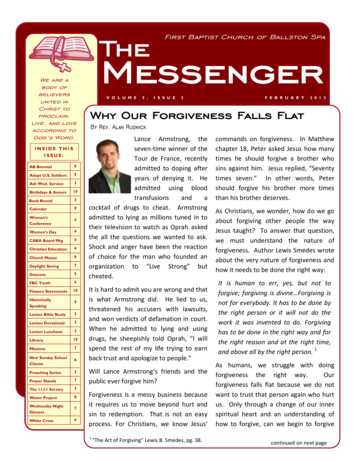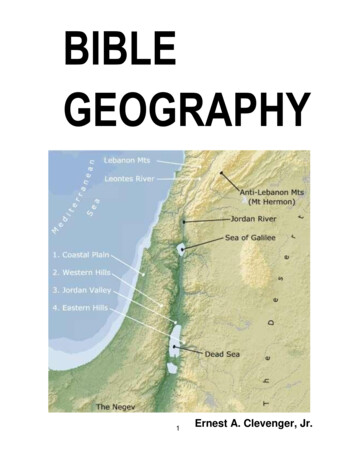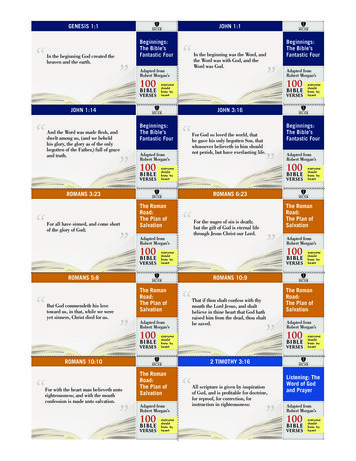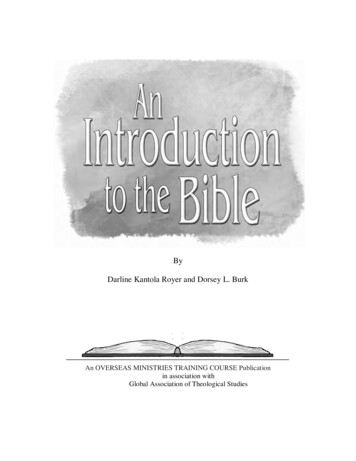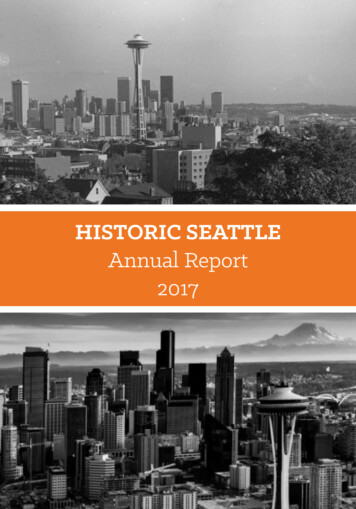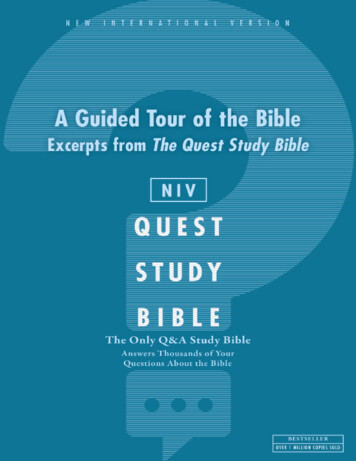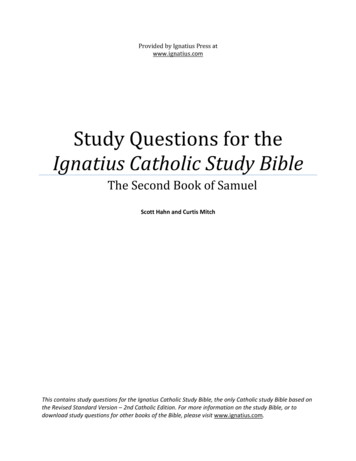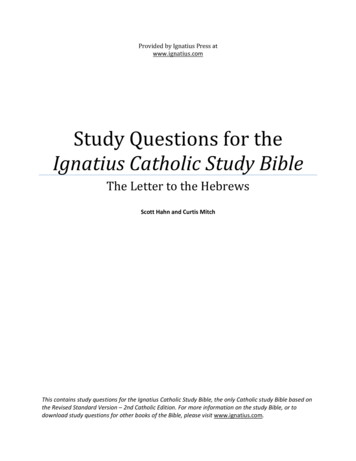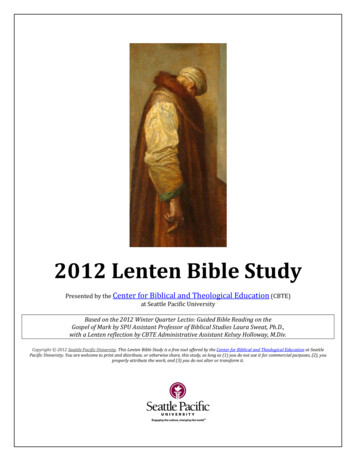
Transcription
2012 Lenten Bible StudyPresented by the Center for Biblical and Theological Education (CBTE)at Seattle Pacific UniversityBased on the 2012 Winter Quarter Lectio: Guided Bible Reading on theGospel of Mark by SPU Assistant Professor of Biblical Studies Laura Sweat, Ph.D.,with a Lenten reflection by CBTE Administrative Assistant Kelsey Holloway, M.Div.Copyright 2012 Seattle Pacific University. This Lenten Bible Study is a free tool offered by the Center for Biblical and Theological Education at SeattlePacific University. You are welcome to print and distribute, or otherwise share, this study, as long as (1) you do not use it for commercial purposes, (2), youproperly attribute the work, and (3) you do not alter or transform it.
Week 1: Ash Wednesday, February 22, 2012One Thing: A Lenten Reflection on Psalm 27By Kelsey Holloway, M. Div.The human experience is composed of rhythms. Those who commute to work are governed by thetraffic patterns and rhythms of rush hour. Our weather patterns change and flux in accordance with therhythm of the seasons. Students alternate between rigorous studies and times of break as aligned withthe rhythm of the school year. Even our cycles of sleeping and waking are dictated by internal Circadianrhythms.The Church CalendarThe same is true for the church. Different times of the year are elevated for the church to celebrate,reflect, and grow in our journey towards Christ-likeness. Each ebb and flow of the church seasons helpsus live into the rhythms of the Gospel with greater intentionality as we remember and reflect on thestory of redemption that God has been writing throughout human history. Additionally, following thechurch calendar is a highly communal endeavor, for as we observe the particularities of liturgicalrhythms we stand alongside our sisters and brothers in faith around the world who are likewisemeditating on the Christian story and striving to live as citizens of the kingdom.It is during Advent that we take up the discipline of waiting, cultivating a posture of prayer andexpectancy as we look toward Christmas and a celebration of the incarnation. The season of Epiphanypoints us to the light and life of Jesus as we reflect on his short time on earth and seek to follow hisexample. In Pentecost we remember the gift of the Holy Spirit and the ongoing ministry of the churchthat is fueled by the invigoration of the third member of the Trinity. Living in these rhythms sets us apartfrom the world in a way that reminds us of our true citizenship and our calling to be the aroma of Christin a broken and hurting world.LentAsh Wednesday marks the beginning of the next chapter of the church year, ushering in a 40-day seasonof repentance and confession known as Lent that culminates in the events of Holy Week. If you are likeme, I once knew Lent only as the time of year that my Roman Catholic friends abstained from eatingmeat on Fridays. Or perhaps under great peer pressure you, too, have participated in Lent by choosing adifferent part of your life to fast from — whether that be chocolate, coffee, or excessive internet usage.These are good practices, but what are they for? It seems we need to take a step backwards in order togain some perspective on the purpose and meaning of this season.Before moving to Seattle I spent three years at North Park Theological Seminary in Chicago. It was awonderful three years, excepting only for the treacherous winters that Chicagoans must endure. Fornearly five months every year, Chicago is subjected to a blustery season of wind, cold, and feet uponfeet of snow. During those months we would hunker down and prepare to simply weather the storm.Let’s just say that it is not a city for the faint of heart.
During my last winter as a resident I began to envision Lent as the process of washing my car after theeffects of a long Chicago winter. For those who are unfamiliar with the effects of Midwest winterdriving, envision your vehicle covered in layer upon layer of a nasty, salty, wintery film. With each newsnow an additional covering of grit clings to your paint job, serving as a constant reminder of thetreacheries of the season. It is an affliction that we bore with dutiful commitment to the city we loved,all the while hoping for warmer days.Now imagine with me what the first mild day in the beginning of March might feel to a winter-wearysoul. The snow has temporarily melted and the first glimpses of spring are on their way. In a moment ofmild insanity you decide to take a stab at washing your car — beginning to strip away the layers thathave been accumulating over the winter months in hopes that something different is on the way.The same thing can happen during Lent. Over the year our hearts and minds can become coated withthe salt, grime, and dirty snow of life. We can become dulled to the realities of the kingdom and merelytrudge through day-to-day existence. Therefore, as we move throughout the year the reflective,repentant nature of Lent could be likened to taking a power washer to the soul. This might not be thetypical image used to describe the church year, but perhaps it sheds a little light on what this season isabout. As we approach the Easter season we want to strip away what is not of God in order that wemight more fully reflect the new creation that was enabled through the work of the cross. We do thisthrough intentional prayer and confession, as well as by taking on various fasts or spiritual disciplines inorder that we might realign our priorities and focus on the one to whom we owe everything.One ThingConsider the prayer penned by the psalmist in Psalm 27:4-6:One thing I asked of the LORD,that will I seek after:to live in the house of the LORDall the days of my life,to behold the beauty of the LORD,and to inquire in his temple.For he will hide me in his shelterin the day of trouble;he will conceal me under the cover of his tent;he will set me high on a rock.Now my head is lifted upabove my enemies all around me,and I will offer in his tentsacrifices with shouts of joy;I will sing and make melody to the LORD.What a beautifully simple request; ponder for a moment if you will on what it would mean for each of usto likewise be defined by this one desire — to want nothing else but to know the goodness of God, todwell in his presence amid all things, and to celebrate at his provision in any and all circumstances. Itseems so simple, and yet this desire is very quickly lost in our daily comings and goings. In our busyness,Lenten Bible Study: SPU Center for Biblical and Theological EducationPage 3
have we taken the time to simply gaze upon the beauty of the Lord? Do we even know what that phrasemeans?A short and powerful book on this theme is The Pursuit of God, by A.W. Tozer. Although written in thelate 1940s, Tozer’s words have an astoundingly prophetic voice for the church of the 21st century. In thefirst chapter he writes:Every age has its own characteristics. Right now we are in an age of religious complexity. The simplicitywhich is in Christ is rarely found among us. In its stead are programs, methods, organizations, and a worldof nervous activities which occupy time and attention but can never satisfy the longing of the heart. Theshallowness of our inner experience, the hollowness of our worship and that servile imitation of the worldwhich marks our promotional methods all testify that we, in this day know God only imperfectly, and thepeace of God scarcely at all.Tozer, The Pursuit of God, 17.Reading this sounds a bit like a description of contemporary Christianity. Even with our good intentions,it is very easy to get caught up in the “good things” of faith, losing the essence of that one thing. It iseasy to lose ourselves in the work that we do, rather than losing ourselves in the presence of God.For those of us who have been journeying with Christ, this probably isn’t a particularly new concept. Infact, most if not all of you have probably heard your fair share of sermons about this sort of theme.However, as Psalm 27 is read in the context of Lent, this reality comes jumping off the page, for it wouldseem that even in our attempts to pursue a life of faith we often get muddled in the details, losing theposture of worship that the psalmist embodies as he yearns for more of God.To be sure, there are things about the life of faith that are far from simple. (Please don’t hear this as aneffortless portrayal of discipleship in which we simply sit around all day with idyllic smiles on our facesas we stare at a picture of Jesus.) However, in a world that is overcomplicated, overcrowded, and overconcerned with the outer appearance, followers of Jesus should long for the simplicity of faith reflectedin Psalm 27, spending more time reflecting on what it means to dwell in the house of the Lord, and tosimply gaze upon the beauty of the one who gives us life.On a practical level, let’s engage in spur-of-the-moment conversations with God as we go about ourworkdays, because we are constantly aware of God’s nearness. Let’s endeavor to be struck by thebeauty of the Gospel even as we see a sunset or experience love through a conversation with a friend.Let’s pursue spiritual disciplines not as obligations, but as a means of stripping away the things in lifethat are not of God in order that we would begin to see things clearly again.As we embark on in our journey toward the cross in this Lenten season, may we be encouraged towardthe pursuit of one thing — namely, the life-transforming presence of our Creator. And even now, as wespend the next five weeks studying Mark, may we be reminded of the grace of the Gospel that draws usnear and nourishes us in order that we might likewise engage in the world with this same Good News.For we pursue this one thing not just for our own sense of pious fulfillment, but for the glory of God andpursuit of his kingdom here on earth.Lenten Bible Study: SPU Center for Biblical and Theological EducationPage 4
A prayer from The Pursuit of God seems appropriate as our closing today. May these words refresh andencourage us to reorder our lives as we continue in Lent, that we might seek the one thing that is trulyneeded.O God, I have tasted Thy goodness, and it has both satisfied me and made me thirsty for more. Iam painfully conscious of my need of further grace. I am ashamed of my lack of desire. O God,the Triune God, I want to want Thee; I long to be filled with longing; I thirst to be made morethirsty still. Show me Thy glory, I pray Thee, so that I may know Thee indeed. Begin in mercy anew work of love within me. Say to my soul, “Rise up, my love, my fair one, and come away.”Then give me grace to rise and follow Thee up from this misty lowland where I have wandered solong. In Jesus’ name. Amen.Tozer, The Pursuit of God, 20.Questions for Further Reflection:1. If you come from a church tradition that regularly follows the church calendar, what do yousee as the significance of such practices? If you do not come from this background, whatmight encourage you to pay more attention to such rhythms now?2. If someone asked you to define Lent and its purpose in your own words, what would yousay? As we begin our study of Mark in this Lenten season, what do you hope to gain?3. Reread Psalm 27:4–6. What stands out to you about this prayer? What steps might you takein these next days and weeks to “strip down” in order to pursue one thing from the Lord?4. Spend some time in intentional prayer and reflection in preparation for our Lenten study ofMark.Lenten Bible Study: SPU Center for Biblical and Theological EducationPage 5
Week 2: Week of February 26, 2012A Lenten Introduction to the Gospel of Mark: Mark 1:1–15By Dr. Laura Sweat, adapted by CBTE Director Celeste Cranston, M.Div.Good news. Death and Darkness. Revelation. Misunderstanding. Miracles. Mystery. Authority. Suffering.All of these contrasting terms characterize the vivid portrayal of good news in the Gospel of Mark. As weembark on a Lenten venture into this gospel, these contrasting terms accompany us and set the stagefor the greatest surprise of all – that Jesus Christ, the son of God Almighty, would lay down his life and inso doing lay out a path of discipleship for us to follow that consists of sacrifice and suffering. In fact, asignificant portion of Mark’s gospel is dedicated to this account of Christ’s passion, death, andresurrection – proportionately more than in any of the other gospel accounts.But before we move toward a study of Mark’s passion narrative, let’s explore a brief introduction to thisgospel. The best way to introduce the Gospel of Mark is to let Mark himself acquaint us with the gospel.The first 16 verses of the gospel serve as an orientation to the narrative to come. They highlight someimportant connections between Jesus, God, and God’s kingdom. Most importantly, these versesemphasize the significance of the Old Testament for understanding Jesus’ ministry, so that the languageof God’s good news (“gospel”) is old, even if the news itself is surprising.Mark begins, not with the birth of Jesus (as Matthew and Luke do), but rather with a general statementof introduction (Mark 1:1) followed by quotations from the Old Testament. Mark contends, as do all theNew Testament writers, that one cannot understand Jesus apart from Jesus’ own scriptures, or whatChristians call the Old Testament.Mark’s use of the Old Testament is often subtle, but here Mark signals that he is quoting from the OldTestament, when he says, “as it is written in the prophet Isaiah” (1:2). However, only the second half ofMark’s quotation actually comes from Isaiah. The first part (“Look, I am sending my messenger beforeyou, who will prepare your way”) is a quotation that combines Exodus 23:20 and Malachi 3:1. Thismisattribution strikes many modern readers as odd, at best.While there may be many reasons for Mark to begin his gospel in this manner, two reasons stand out assignificant for our reading of the rest of the gospel.1. First, it is noteworthy that the book of Isaiah plays a particularly prominent role in the gospel asa whole. Mark quotes from Isaiah at central points in his gospel, and many of the themes ofIsaiah seem to be evoked or reenacted in Jesus’ ministry. For this reason, Mark may identifyIsaiah as his primary Old Testament prophetic voice simply to call to mind the significance ofIsaiah’s prophecies so that the reader is prepared to encounter them in the coming chapters[Author’s Note 1].2. Second, however, there is a theological reason for Mark to conflate other words with Isaiah’s.For Mark, as for New Testament authors as a whole, Old Testament Scripture was a text intowhich life had been breathed by the Holy Spirit. The Spirit’s presence, in light of Jesus’ life,death, and resurrection, now helped the church (of whom Mark was a part) interpret ScriptureLenten Bible Study: SPU Center for Biblical and Theological EducationPage 6
rightly. To this end, Jesus’ coming has empowered his followers with the ability to read Scripturewith open, fresh eyes.Indeed, one of the new ways in which Mark wants his readers to read the Old Testament involvesScripture’s coming to life before their eyes. John, the baptizer, is introduced by these scriptures in Mark1:2–3, but his physical appearance and actions bring another figure of the Old Testament to mind: Elijah.Just as Elijah was a prophet in the wilderness who called all Israel to turn back (“repent”) fromworshipping the Canaanite god Baal (1 Kings 18:21; 2 Kings 1:8), so John calls “all the country of Judeaand all the people of Jerusalem” to repent (Mark 1:5). John’s role is one of preparation. Baptism was ameans of purification, of symbolizing the turning aside from one way of life and turning toward a newpath.John, resembling Elijah in appearance and action, has come to prepare the way for someone greater(1:2–3, 7–8). John’s baptism also prepares the way for a greater baptism to come, a baptism by the HolySpirit. Yet, when we meet Jesus in the Gospel of Mark, he is given the briefest of geographicalintroductions (“from Nazareth of Galilee,” 1:9), and Mark describes Jesus submitting to John’s baptism.In this way, Mark’s brevity in narrating Jesus’ baptism focuses less on John (we already know he thinksJesus is superior to him: 1:7) and more on Jesus’ relationship with God. After Jesus is baptized, Mark’saudience is given an insider’s glimpse at Jesus’ connection to God. Here we see what later Christians willcall the Trinity: God the Father, the Son Jesus, and the Holy Spirit as a dove, all appearing at once.The appearance of the Spirit and the voice of God are possible because the heavens have been “rippedopen.” The Greek verb here is σχίζω, meaning “rip or cleave in two.” The image may refer to a passagein Isaiah 64:1, where the prophet calls to God: “O, that you would open the heavens and come down[author’s translation]!”Mark narrates Jesus’ baptism in the same way that he portrays John: it is an enactment of OldTestament prophecy. Here, God does rend the heavens and come down to earth in Jesus. If we miss thisallusion, the connection between Jesus and God is certainly made clear by the words God speaks: “Youare my beloved son, with you I am well-pleased” (1:11). As we have already seen with many statementsin Mark 1, this, too, is an allusion to the Old Testament. As God has formerly called the king of Israel“son of God” (e.g., Psalm 2:7), here God calls Jesus not just a son, but a beloved son (see Genesis 22:2,12, 16). This love and pleasure that God takes in Jesus is the foundation for the rest of the gospel’s story.Of course, what God’s love of Jesus means is immediately (to use one of Mark’s favorite words) put tothe test as the Spirit “kicks Jesus out” (the literal meaning of the Greek verb, ἐκβάλλω) into thewilderness. Yet again, we recognize an Old Testament allusion: Israel, too, was led out into thewilderness at the beginning of its “ministry.” Later generations of Israelites remembered this time in thewilderness as a time of testing (see Psalm 95:7–11), and also a honeymoon period (see Hosea 2:14–23).Jesus’ own time in the wilderness seems to have both of these interpretations as its background. Jesus istempted by Satan (Mark 1:13), which clearly coordinates with the Israelites’ own temptation. But whenMark says the wild beasts attend Jesus, it is uncertain whether these beasts are part of the temptation,or a kind of allusion back to the Garden of Eden (compare Isaiah 11:1–11), pointing to a more positivetime, or honeymoon, in the desert. Either way, just as Israel’s 40 years in the wilderness served asLenten Bible Study: SPU Center for Biblical and Theological EducationPage 7
preparation for their coming to the Promised Land, so Jesus’ 40 days in the wilderness prepares his ownway for his ministry.Likewise, our journey in Lent for 40 days can also be both a time of testing in the wilderness and ahoneymoon of sweet communion with God. As we trust him more completely and rely upon him toprovide for our every need (allowing the “slime” of our daily lives to be washed away as described in thefirst reading), we do so in faith remembering that God provided for Israel in their desert wanderings andthen later for Jesus in his wilderness sojourn. And this season can also be a means of preparation for usas we look ahead toward Holy Week and to a celebration of the resurrection.Good News About GodJohn’s time of preparation is over by the end of Mark’s introduction: he has already been arrested, andwe will not hear the end of his story until Mark 6. The conclusion of John’s ministry of preparationsignals the beginning of Jesus’ own ministry. He begins in Galilee, his home (1:9, 14), and he launches hisministry by preaching “good news about God.”God is now doing something new, as “the time has been fulfilled, and the kingdom of God has comenear” (1:15). This is God’s good news: the time has come for new things! But as God has done before,these new things are described in the language of the old things so that the new is an integral part of theold. Mark’s summary of Jesus’ preaching is almost exactly the same as John’s, and also is the call of theprophets of old: “turn around and put your trust in the good news” (1:15).Throughout the Gospel of Mark, we see Jesus saying and doing surprising things: He calls a rag-tag set of disciples to follow him without a job description, details, or any specificson what this will mean. And they do follow — immediately!He teaches with authority; exorcizes demons; miraculously heals the sick, lame, and paralyzed;and continues to care for those whom society rejects, breaking open old categories andexpectations about this kingdom.With authority, Jesus redefines the Sabbath, redefines family, and redefines Satan’s defeat byassociating it with the forgiveness of humans. All of these point to a redefinition of the kingdomof God which Jesus explains via a set of surprising parables, thus implying that the enigmatic andthe mysterious are a central part of this kingdom, at least until all is revealed at the end (4:21–22).Further exercising this authority, Jesus shows dominion over the sea, which he calms with aword. Living out these upside-down kingdom values, he enters Gentile territory to cast out alegion of demons, and then interrupts his journey to a Jewish leader’s home to stop and heal anoutcast, hemorrhaging woman whom he calls daughter. When he picks up the journey again heproceeds to raise the leader’s now dead daughter to life.As his ministry expands, opposition towards it also grows, especially from established religiousleaders. But Jesus commissions his disciples and sends them out nonetheless with authority toproclaim the good news and exorcise demons.In spite of the success of the disciples’ ventures, it is clear that they don’t really grasp Jesus’mission and purpose. They anxiously worry about having enough to eat after having witnessedJesus’ miraculous feeding of the 5,000, seeing him literally walk on water, and then againwatching him feed another 4,000.Lenten Bible Study: SPU Center for Biblical and Theological EducationPage 8
These words and deeds were not only surprising to the scribes, Pharisees, disciples, and various othercharacters in Mark’s gospel: they may also be surprising and sometimes even dumbfounding to thereaders of Mark’s gospel, 2,000 years later. Mark will use old language to describe new things, so thateven what is predicted surprises us. Surprises unite the many themes of Mark’s gospel, as Markdescribes the coming of God’s kingdom as vivid contrasts, bringing light and darkness, revelation andmisunderstanding, life and death. In Mark, surprise is foundational to understanding God’s good news:only when the gospel is surprising can it shape and change our lives into the lives of disciples, who findlife by losing it [Author’s Note 2].Questions for Further Reflection:1. How does Mark refer to the Old Testament in the introduction to his gospel (1:1–15)? Note acouple of different ways. What impact does this have on you as the reader?2. Given the discussion above about Mark 1:9–15, how would you describe God’s relationship withJesus? Are there times in your life when you understood God’s love and pleasure in you? Whatabout times when you feel that the Spirit has brought you to the wilderness? Looking back, haveany of these times been preparation for a season of ministry in your own life?3. As you look ahead to your own Lenten journey of discipleship, in what ways might surprise benecessary for you to grow as a disciple of Jesus?Author’s Note 1Mark seems indebted to several themes of the book of Isaiah, and here we should note three.1. First, as we can see from Mark 1:2–3, Mark uses the term “the way of the Lord” to describewhat John the Baptist is preparing. This “way” is a common term in Isaiah, describing the pathGod is walking to lead Israel from exile back to their home, Jerusalem (for examples, see Isaiah40:3, 13; 42:16, 24; 43:16, 19).2. Second, as we mentioned above, Isaiah’s descriptions of God creating a “way” in the wildernessspark images of a new Exodus in both Isaiah and then again in Mark. God again will lead thepeople from slavery to redemption.3. Third, another theme that has its origins in the Exodus narrative but is recapitulated in the bookof Isaiah is the theme of blind eyes, deafened ears, and hardened hearts. As Pharaoh hardenedhis heart and had his heart hardened in Exodus, so Isaiah proclaims that God is the one whohardens and softens Israel’s hearts. This same imagery will appear more than once in the Gospelof Mark, and highlights the significance of the prophecies of Isaiah for the gospel.Author’s Note 2I have been indebted to more than a few scholars in my reading of the Gospel of Mark. I have foundmany commentaries useful, and here I may only list a limited number: Black, C. Clifton. Mark (Abingdon New Testament Commentaries; Nashville: Abingdon, 2011)Boring, M. Eugene. Mark (New Testament Library; Louisville: Westminster John Knox, 2007)Lenten Bible Study: SPU Center for Biblical and Theological EducationPage 9
Marcus, Joel. Mark (2 volumes; Anchor Bible Commentary 27 and Anchor Yale BibleCommentary 27A; New York and New Haven: Doubleday and Yale, 1999, 2009)For accessible work on Mark, I cannot recommend highly enough these two works: Byrne, Brendan. A Costly Freedom: A Theological Reading of Mark’s Gospel (Collegeville:Liturgical Press, 2008)Juel, Donald H. A Master of Surprise: Mark Interpreted (Minneapolis: Fortress, 1994)Lenten Bible Study: SPU Center for Biblical and Theological EducationPage 10
Week 3: Week of March 4, 2012The Cross of Discipleship: Mark 8:22–10:52Looking Forward: The Importance of Good Vision (8:22–26)This week we reach the halfway point of Mark’s gospel. However, Mark sets up the narrative so that it ismore like a halfway pivot than a halfway point: this section looks backward to Jesus’ ministry throughGalilee, and forward, as we travel to Jerusalem (11:1). In fact, the gospel is increasingly focused onJerusalem and the fate that awaits Jesus there. While much of the first half of Mark emphasizes Jesus’unwavering authority over the forces arrayed against the kingdom of God, the second half focuses onJesus’ life, as Jesus seeks to teach his disciples about his impending suffering and death.Mark sets up his gospel in such a way to emphasize the importance of Jesus’ suffering and death as wellas how the lives of Jesus’ followers should mirror Jesus’ sacrifice and suffering. So far, the narrative hasmoved at a frenetic pace, with Jesus crossing the Sea of Galilee and traveling great distances every day.Now we slow down both geographically and narratively.The focus is not the travel; it is the teaching. In fact, Mark sets two similar stories as bookends to thissection, directing the reader’s attention inward to the chapters between the two healings. In bothhealings, Jesus cures a blind man, and these healings seem to function as more than just an additionalproof of Jesus’ power over illness. Metaphorically, they emphasize to the reader how important seeingrightly is.In the first healing (8:22–26), Jesus does not heal the man instantly. Initially, the man cannot see clearly.He sees “people, but they look like trees walking” (8:24). Like the blind man, Mark’s audience is grantedrepeated instances of Jesus’ disciples being able to see, but what they see resembles things more liketrees than people.In other words, they continue to misunderstand Jesus’ identity and mission, and therefore their ownrole in following Jesus. The second stage of the blind man’s healing, bringing sight and understanding ofwhat is being seen, provides hope that the disciples will ultimately both see and understand [Author’sNote 1].The Crossroads: Caesarea Philippi (8:27–9:1)Jesus and his disciples are at Caesarea Philippi, the northernmost point of Jesus’ travels in the Gospel ofMark. Jesus asks his disciples what people are saying about him. We have seen this dialogue in thenarrative before. When Mark pauses to narrate John the Baptist’s death in Chapter 6, we hear that Jesusis thought to be John the Baptist raised from death, Elijah, or one of the prophets (6:14–16).The same is true here. As we have noted, Jesus’ proclamation of repentance and forgiveness is verysimilar to John’s preaching. Jesus’ miracles echo some of Elijah’s. Jesus certainly speaks with the scribesand Pharisees as one of the prophets, criticizing their understanding of holiness (e.g., Mark 7:1–23).Jesus then asks the all-important question: “Who do you say that I am?” Acting as the speaker for thedisciples here, Peter answers, “You are the Christ” (8:29). It seems that the disciples are actually seeingLenten Bible Study: SPU Center for Biblical and Theological EducationPage 11
rightly. They see that Jesus is the Christ, something that Mark’s readers have known since Mark 1:1, ifnot before.However, just saying Jesus is “the Christ” does not explain what it means. Christ is the Greek word forthe Hebrew term Messiah. Both mean “anointed one,” and originally referred to kings who wereanointed with oil when they became king (e.g., 1 Samuel 16:12–13). Later the term meant a personthrough whom God is accomplishing particular purposes (e.g., Isaiah 45:1).As time passes and Israel is subjected to one imperial rule after another, some Jews hope that God willsend another figure, another Anointed One, who will restore Israel to the glory days, usually imagined asa return to King David’s rule. From the texts we have dating from the centuries around Jesus’ time, weknow that there were people who claimed to be the Messiah and even gained followers. When thesemessiahs were killed, their followers disbanded. Their death indicated that they were false messiahs andnot the true Messiah.Given the discussions that follow Peter’s proclamation, it seems that Peter may have c
that is fueled by the invigoration of the third member of the Trinity. Living in these rhythms sets us apart . it is very easy to get caught up in the "good things" of faith, losing the essence of that one thing. It is easy to lose ourselves in the work that we do, rather than losing ourselves in the presence of God. .

